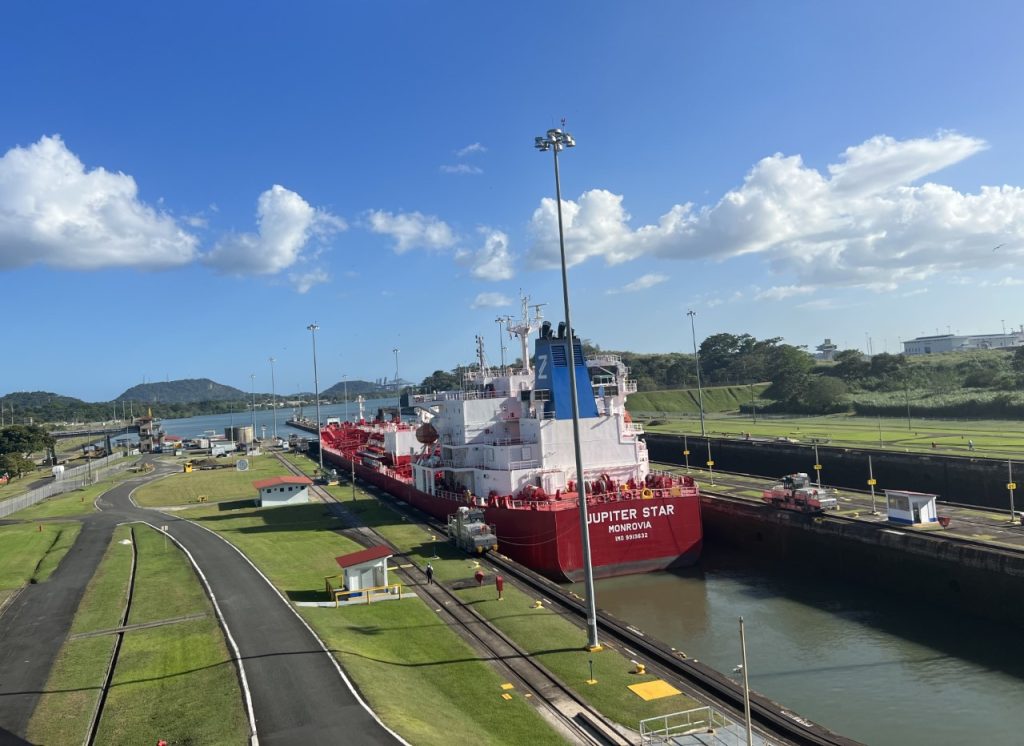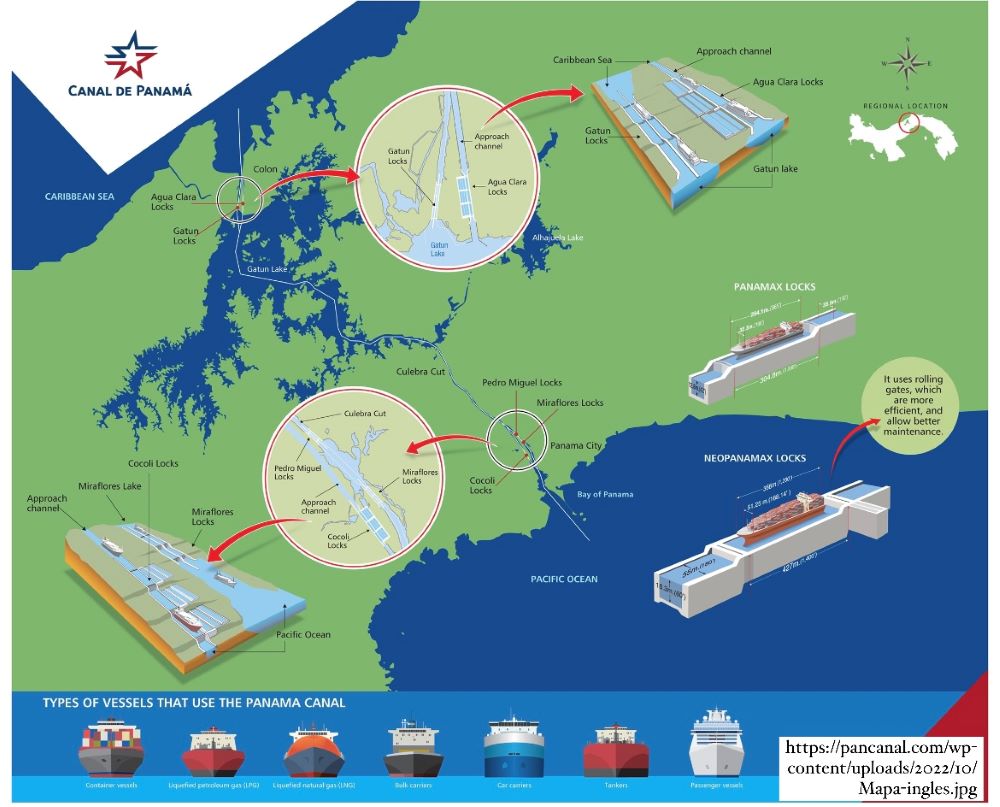On our walking tour in the morning, we visited a dilapidated church which held evidence of why Panama was chosen for the canal. A stone bridge, or archway, was constructed out of bricks in the church. A Frenchman distributed a picture of that arch with a picture of a Nicaraguan postage stamp with an erupting volcano on and convinced the government that Panama would be better suited as it was therefore safer.

The church was originally built in 1688, and with the photo being distributed in 1902, he made a good point. To this day, the arch is undisrupted. Prior to heading to the Canal, we visited the Museo del Canal Interoceanico de Panama. The building that housed the museum was first the headquarters for the French Canal Project and then became the US’ canal base. The museum exhibits provided us with lots of background of the Canal including the disease, prejudice, and fight for sovereignty. The Canal was held by the United States up until 1999 when President Jimmy Carter signed the rights over to Panama. There was a period of transition where the Canal changed ownership and the new teams were caught up to speed on maintenance and operations. The path to ownership was long and hard for Panama but now the ownership lies with the people. This is definitely an oversimplification of a complicated history which will be described a little more in a later post. After lunch, GLCM got our first look at the Panama Canal. We boarded our yellow bus and headed to the Miraflores Locks.

The first thing we did was enjoy some much needed caffeine and snacks in the theater concessions. Once our movie showtime arrived, we sat down for an Imax projection of the Expansion of the Panama Canal narrated by, none other than, Morgan Freeman.

Ferdinand de Lesseps, the French consul to Cairo, proposed the creation of the Panama Canal. He also spearheaded the creation of the Suez Canal in Egypt, however, Panama had a very different terrain which came with a variety of issues. Over twenty thousand French people died in the process of cutting into jungle and rock. A lot of this was due to yellow fever which they believed to be from poisonous vapors in the rainforest. High death rates led to lack of investment backing and ultimately the demise of the French’s involvement in the project. When the French abandoned the project, the Americans took over and made disease control a priority. After leaps in research, the Americans had a plan to eradicate the pests responsible for the disease, mosquitos. With yellow fever in check, Americans could place less worry on the survival of their workers and more on the problem at hand. The Chagres River was the biggest threat to the success of the project. Building a canal at sea level was a lot more work than anticipated. The solution was to not build the Canal at sea level but instead create a smaller lake with locks that transitioned the Ocean to the Canal and back again. Eventually this lock system, which was based on diagrams created by Leonardo di Vinci was tested and finalized. The whole Canal took 10 years to complete. The first official passage through was in August of 1914. The lock gates are eight stories tall and were the largest ever locks at the time of construction. The Canal takes on average eight to ten hours to cross once started and around twenty four hours total to cross including time waiting to enter the first lock. This is a giant time savings compared to the original trip around South America which amounted to around 8000 miles and three weeks of time.

The crossing of the Canal is a carefully organized endeavor which requires the use of freight cars, or mules, which can pull 35 tons each with the biggest boats requiring eight mules to steer. The mules are directed by the Canal guides to position the boats through with less than a foot of clearance on either end at times. However, some new boats are actually too big to be positioned via the mules and are controlled by tugboats on either end. The actual control of the locks is now done via computer controlled hydraulics but used to be by hand for over one hundred years.

Due to new developments in shipping, the boats got bigger and carried more cargo through the years. In 2007 the Panama Canal Expansion Project began in order to allow larger shipments and vessels through the Canal. Notably, the project was led by the Executive Vice President of Engineering, Ilya Espino de Marotta, who was the first woman in the history of the Panama Canal Authority to hold the role. This project included the installation of new locks and water reservoirs on the side to raise the water level of the passageway, or Gatun Lake. The project was eco-friendly and promised a giant influx of income. Nine years and $5.6 billion dollars later, the project was finished. One fun fact about this project that we learned from our tour guide was that for two weekends, prior to filling the new locks with water, the Panamanian people were welcomed to walk through the passages and see a unique perspective that would not be seen again.
Obviously, the Canal charges a toll in exchange for passage through. This generates about 15 million dollars a day now. Which means that in 373 days, Panama could roughly pay off the cost of the expansion if all revenue went towards that project. There are a variety of things that money goes to but the majority is to the government and then to maintenance of the Canal itself. Historically, just around $1,205,500 is the largest toll ever paid to cross which was paid by an OOCL Poland ship traveling with 13,964 shipping containers. The smallest toll ever was paid by Richard Halliburton who swam the Canal in 1928 and, because the toll was exclusively paid by weight, paid only thirty-six cents. The toll is now a fixed fee plus weight.
I did not know what to expect from the Imax movie and observation of a ship passing through the Miraflores locks, but I was amazed by the process at the end. It is one thing to hear about the Canal and watch a movie about what it took to create it, but seeing it in action was a sight to behold. It is also interesting to note that the Imax production said the Panama Canal Authority is more of a water management company than anything else as the locks are gravity operated and their job is mainly to manipulate the flow of the water. We could relate as the construction managers of the future.
This section of our day was definitely spent taking in a lot of information and was complemented nicely by an evening trip to Cinta Costera where we walked along the water, took pictures, and stopped for food at El Mercado de Mariscos (The Seafood Market)

We enjoyed ceviche and the ambiance of a man singing karaoke and playing the air guitar. As we walked back along the coast we saw vendors selling hot dogs, shaved ice, fruit, and toys. We took in the views of the skyline at night, and saw a couple of stray cats.
Blog by Juliana Roznowski

